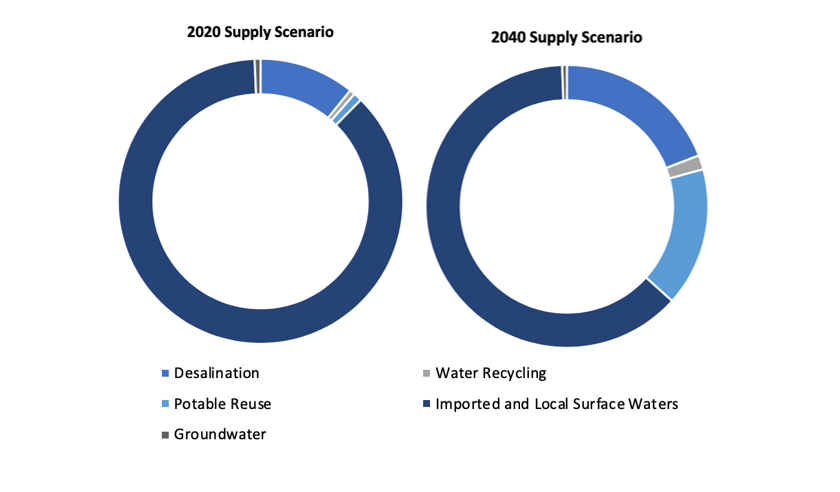Water’s Rising Energy Intensity May Alter Landscapes in San Diego
Though California’s historic drought—and governor-mandated 25% water restrictions—officially ended three years ago this April, serious challenges remain to assure water security for the state’s households and water-intensive industries. In March, lower-than-average snowpack in the Sierra Nevada mountains after a dry January and February raised new concerns for Californian water authorities that rely on winter runoff in summer months.
For water-stressed regions, water and energy are deeply interrelated commodities. Not only is water used in virtually all phases of energy production and generation, water extraction and delivery can be staggeringly energy intensive—especially without access to abundant surface water resources such as lakes and rivers. In California, where large quantities of water must be conveyed hundreds of miles from temperate northern regions to the more arid south, the water system consumes nearly 20% of statewide electricity and 30% of natural gas demand. All together, these processes account for roughly 10% of the state’s greenhouse gas emissions.
Rising water demand from growing urban populations and a statewide shift from annual to perennial cropland, coupled with the warming climate’s impact on mountain snowpack will strain surface water resources, leaving counties with few alternatives other than developing new, energy intensive, methods of securing fresh water.
To reduce reliance on northern resources, the San Diego County’s Water Authority (SDCWA) has planned for a significant diversification of their local supply. By 2040, the proportion of imported water is projected to fall 25%, replaced by local desalination and water recycling. By 2040, the SDCWA projects total desalination capacity will be roughly double the output of San Diego’s $1 Billion Carlsbad Desalination Plant, “the largest desal plant in the western hemisphere.” Perhaps even more ambitiously, the proportion of water supplies from potable recycling is projected to increase from less than 1% to 15% over the same period.

In 2015, imported surface waters met roughly 80% of San Diego’s demand with an energy intensity of around 1,600 kwh/acre-foot. If the water authority projections prove to be accurate, the consequences of relying on supplies such as potable recycling and desalination, which is around three times as energy intensive, will bring significant costs—both to ratepayers and the local environment. To make matters more complicated, SDCWA projections assume future water conservation, including the conversion of one quarter of all family homes to water-efficient landscapes. Post-drought trends, however, show increasing annual water consumption for San Diego residents.

Both expected energy use and new statewide permanent water restrictions highlight the necessity for San Diego to redouble residential conservation efforts. With a mandated reduction in per capita water use of 40% by 2022, offering rebates for more efficient household appliances is not going to be enough to assure San Diego reaches the state’s water targets. Examining the difference in water demand from district to district reveals that residential landscapes themselves must undergo a transformation from water intensive lawns to desert-native plants. Recent data reports San Diego’s affluent and gardened Santa Fe district consumes an average of 350 gallons per resident—over five times the statewide target. As residential water use is projected to account for 66% of city water demand in 2020, reducing the acreage of water-intensive lawns can significantly impact city water savings.
Southern Californian water authorities at both the city and regional level have long offered rebates for turf replacement programs and efficient irrigation technologies, but these programs are often too costly for many Californians. While SDCWA’s WaterSmart Landscape Makeover program offers free resources to homeowners looking to pursue regionally appropriate landscaping, parting with the classic American lawn in favor of drought-resistant native vegetation will not see widespread adoption until ratepayers are confronted with tough, fine-enforced, drought limits or a considerable rise in rates. Considering the SDCWA’s climbing energy intensity, significant new costs will inevitably be passed on to ratepayers within the next 20 years.
